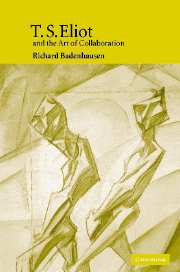Book contents
- Frontmatter
- Contents
- Acknowledgments
- List of abbreviations
- Introduction – Reaching the stillness of music
- 1 “Speaking as ourselves”: Authorship, impersonality, and the creative process in the early essays
- 2 A conversation about “the longest poem in the English langwidge”: Pound, Eliot, and The Waste Land
- 3 “Helping the poets … write for the theatre”: The transitional essays on collaboration, community, and drama
- 4 A dramatist and his midwives: Eliot's collaborations in the theatre
- 5 The Possum and the “creating critick”: Eliot's collaboration with John Hayward
- Conclusion – Placing collaboration in perspective: Voice and influence in the late essays
- Notes
- Index
4 - A dramatist and his midwives: Eliot's collaborations in the theatre
Published online by Cambridge University Press: 22 September 2009
- Frontmatter
- Contents
- Acknowledgments
- List of abbreviations
- Introduction – Reaching the stillness of music
- 1 “Speaking as ourselves”: Authorship, impersonality, and the creative process in the early essays
- 2 A conversation about “the longest poem in the English langwidge”: Pound, Eliot, and The Waste Land
- 3 “Helping the poets … write for the theatre”: The transitional essays on collaboration, community, and drama
- 4 A dramatist and his midwives: Eliot's collaborations in the theatre
- 5 The Possum and the “creating critick”: Eliot's collaboration with John Hayward
- Conclusion – Placing collaboration in perspective: Voice and influence in the late essays
- Notes
- Index
Summary
Eliot's involvement with the Group Theatre, which he joined officially in 1934, two years after its founding, gave him an association with an artistic community that not only sanctioned collaborative achievement but held it up as an ideal, both in the name of the acting company and in its artistic manifestos. A draft of one of those manifestos proposes that creative success would occur “by continually playing together … work[ing] like a well-trained orchestra.” As in Eliot's many attempts to look to other disciplines for models of artistic success, this approach demanded that the individual suppress his personal needs for the greater good of the whole. The Group's interest in countering what its members believed was a degenerate, commercial theatre through the ideal of an amateur dramatic community that would synthesize the many different elements of theatre – from movement to speech to design – also accorded with Eliot's formal introduction to the theatre through the same route. Productions of The Rock and Murder in the Cathedral, for example, depended in large part on amateur performers of varying talents and backgrounds gathered together in the spirit of fellowship and cooperation to bring off the dramas successfully. This approach represented another significant departure from Eliot's early modernist stance in the criticism, which sought to inflate the status of the literary enterprise by lauding the benefits of its professionalization, despite concurrent calls for a restoration of England's great nineteenth-century amateur tradition.
- Type
- Chapter
- Information
- T. S. Eliot and the Art of Collaboration , pp. 142 - 164Publisher: Cambridge University PressPrint publication year: 2005



